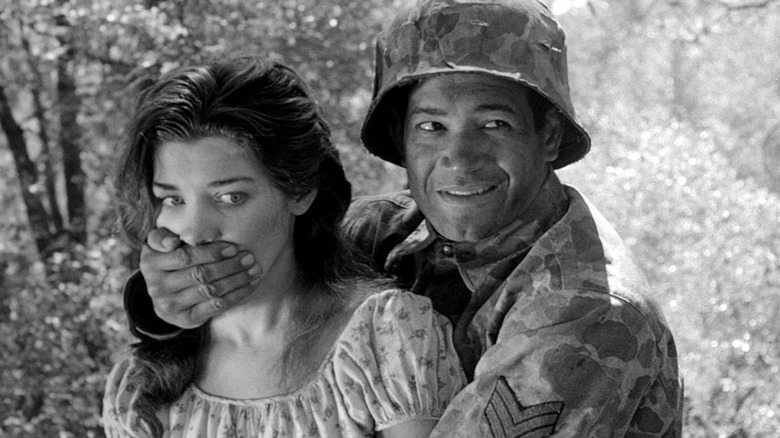Stanley Kubrick has often been accused of being a cold and educated filmmaker. His famous cinematographic domain and his notorious perfectionism have resulted in beautifully composed but emotionally distant films, with protagonists that there are not as many people as a puppet in Kubrick’s psychological dramas.
Advertisement
These are fair criticisms, but one must immediately take into account that they usually only apply to Kubrick’s later films. The characteristic “coldness” of Kubrick, marked by long shots, long shots and slower edition, did not really begin Until “2001: a space odyssey” In 1968, and that film was not so much of a single character as of all humanity. Others familiar with their work in “The Shining” have noticed how strangely inhuman that all the characters feel. Prior to 1968, However, Kubrick Was A Holly Smart Eithher A Naturalistic Grit or, In The Case of “Spartacus,” to Traditional Hollywood Sheen.
Advertisement
Remember that Kubrick was a news photographer before being a filmmaker, and more commonly took photos of everyday life. Some could have seen their famous boxing photographs of 1949. I was not establishing shots and organizing fictions. I was capturing the real world.
That real world’s sand is in all Kubrick’s first feature film, a film against the war called “Fear and Desire” that was thrown in the United in the spring of 1953. Kubrick had already cut his teeth with two documentary shorts, and decided that it was the right time to make a writing function. It was a small matter. According to the reports, the budget was less than $ 50,000, with much of Kubrick’s friends and family.
Kubrick, then we will learn, hate the result. He tried to destroy the original negative.
Fear and desire is a gloomy antiwar movie
“Fear and desire” was a modest issue. It had a complete crew of only 14 people, including Kubrick and the five cast members. The film was filmed in the mountains of California in San Gabriel, where hundreds of low -budget films and Hollywood movies would congregate. It was also, compared to the solid experience of Kubrick’s later films, a bit unpleasant. Initially, Kubrick intended to film the movie without sound to save money, but then decided that the sound was necessary, which adds to the budget. Also accidentally made an error of continuity at the end of the film, a character enters the frame from the wrong side, which forced him to turn the negative, an additional expense.
Advertisement
Kubrick did not have a marijuana platform or a track to make soft tracking shots, so he put his camera in a baby carriage. The anti -harbing machine was just a crop sprayer with some of the DDTs that still remained inside. Ingenious and low budget filmed at its expression.
The story of “fear and desire” follows four soldiers to collide their plane several miles behind the enemy lines. The nations at war are never named. The film follows its gloomy trip through the forest in an attempt to reach its battalion. Some enemy soldiers find in a house and kill them for their food. They find a peasant girl who meets a dark destination in her hands. One of the soldiers, played by Future film director Paul Mazursky (“Moscow in the Hudson”)He goes crazy. The film ends with an infiltration of an enemy base and a meeting with compatriots, followed by a gloomy conversation about the nature of war. “We have all traveled too far from our own private limits,” says one of them. “I’m all mixed,” says the other. “I would like to want what I wanted before.”
Advertisement
Kubrick tried to burn each impression of fear and desire
Funny Trivia: The peasant who is approached by the character of Mazursky was played by actress Virginia Leith, who performed the avengative head cut into the popular film B “the brain that would not die.”
“Fear and Desire” debuted at the Venice Film Festival in the summer of 1952, and was launched in the cinemas the next spring. It was not a success. He came and left without warning. Unfortunately, the film’s distributor, a man named Joseph Burstyn, died in November 1953, leaving unknown the destiny of “fear and desire.” Bursstyn’s company closed, and the only known impression remained with Kubrick. As movie students can easily tell you, Kubrick tried to burn it. In fact, Kubrick was so assaulted by his final film that he tried to collect all the impressions he could find and destroy them as well. She felt that the movie was fond of.
Advertisement
Fortunately for the public, some collectors maintained several impressions of “fear and desire”, and lived enough to be revived in the film forum in Greenwich Village. Specifically, the impression in question belonged to George Eastman House, a photography museum. Kubrick tried to close the film forum exhibition, but could not since the copyright of the film had expired and was now in the public domain. It would not be until 2010 to emerge a complete, complete and original impression of “Fear and Desire”, after being found in a film laboratory in Puerto Rico. Since then it has been completely restored And now it can be found in Blu-ray. In addition, since it is in the public domain, you can simply Watch the full movie on YouTube.
Kubrick minimized how good the “fear and desire is. The dialogue is a bit Mawkish and Predict, and the violence a bit hard, but the misty and contemplative tone makes the film unique. Kubrick may have been known for his domain of film crafts, so it is refreshing that candidates for filmmakers see that he also began in low -budget trenches.
Advertisement








